What is the Perfect Tie Length?
The Importance of Tie Length
Tie length might seem like a minor detail, but it can make or break an outfit. An incorrectly sized tie can make you look sloppy or even draw attention away from the rest of your attire. On the other hand, a properly fitted tie can enhance your overall appearance and help you stand out in a positive way.
When choosing your tie length, it’s important to keep in mind that different occasions and settings may call for different styles. Whether you’re dressing for a job interview or attending a formal event, selecting the right tie length is crucial.
The History and Evolution of Tie Length
The history of ties goes back to ancient times when Roman soldiers wore them as part of their uniforms. Shortly afterward, Chinese soldiers also began wearing ties as part of their battle attire.
The modern necktie as we know it today didn’t come into existence until the 17th century when Croatian mercenaries wore cravats around their necks while serving in France. Since then, tie length has evolved with fashion trends over the years.
In the early 20th century, shorter ties were popularized by British designers who aimed for simplicity and practicality. In contrast, longer ties became fashionable during the 1950s and 1960s when men started wearing wider lapels and trousers with higher waistbands.
Today, there are many factors to consider when choosing the perfect tie length that will work for your body type and personal style preferences. With so many options available on the market today, it’s essential to understand how different lengths can impact one’s overall appearance before making your final selection.
Understanding which tie length works best for you is essential if you want to create stylish outfits that suit any occasion or setting. By considering factors like body type and personal fashion sense along with the history and evolution of tie length, you can choose a tie that complements your individual sense of style while still maintaining a professional appearance.
The Basics of Tie Length
Before we dive into the nitty-gritty of finding the perfect tie length, it’s important to understand the basics. The standard tie length measurement is typically between 56 and 58 inches long, with widths ranging from 2.5 to 3.5 inches. However, there are variations available in both longer or shorter lengths and different widths.
Factors that Affect Tie Length
When determining the appropriate tie length for your body type and height, there are several factors to consider. For instance, taller individuals may require a longer tie to ensure it reaches their waistband without being too short once they knot it. Conversely, shorter individuals may want to go for a shorter tie as longer ones can swallow them up.
In addition to height, body type plays a role in the appropriate length of a tie. A wider or more muscular chest may require a slightly longer or wider tie than someone with a more slender frame.
How to Measure and Adjust Tie Length
To determine what length works best for you, start by measuring your neck size and adding approximately six inches to that measurement (this is the standard method). Once you have your desired length figured out, you can adjust it slightly based on your height and body type. If you find that most ties are too long for you once they’re knotted, consider investing in a shorter tie or having one tailored specifically for you.
On the other hand, if most ties end up being too short once knotted around your neck or over your shirt collar band, try finding ties that offer extra length options (some companies offer extended sizes) or have one custom made. Another useful tip when adjusting tie lengths is experimenting with different knot styles; some knots require more fabric than others, so switching up the knot you use can drastically change the length of your tie.
Finding Your Perfect Tie Length
Understanding your body type and how it affects your choice in tie length
When it comes to choosing the right tie length, understanding your body type is crucial. If you have a shorter torso or are on the shorter side, a longer tie can overwhelm your frame and make you appear smaller.
On the other hand, if you have a longer torso or are taller, a shorter tie may look out of proportion. Another factor to consider is your neck size.
A wider neck may require a slightly longer tie to ensure it reaches the waistband of your pants. Additionally, if you have a larger belly, a slightly longer tie can help create an elongated silhouette.
Tips for determining the right tie length for your height
To determine the right length for your tie based on height, start by measuring from the base of your neck down to where you want the tip of your tie to fall. For most men, this will be just above their belt buckle.
As a general rule of thumb, taller men should opt for ties that are at least 58 inches long while shorter men may prefer ties that are closer to 52 inches long. However, these measurements can vary based on personal preference and body proportions.
How to experiment with different lengths to find what works best for you
Once you have an idea of what length may work best based on body type and height, don’t be afraid to experiment with different lengths and styles. Try tying knots at different heights or opting for narrower or wider ties to see how they look with various outfits and collars.
It’s also worth trying out different fabrics as some materials may drape differently than others. Ultimately finding the perfect tie length is about trial and error until you find what feels most comfortable and looks best on you.
Styling with Different Tie Lengths
The impact of different lengths on overall style
The length of your tie can have a significant impact on your overall style. A tie that is too long or too short can throw off the proportion of your outfit and detract from your overall appearance.
A well-fitted tie, on the other hand, can enhance and complete your look. A tie that falls just above the waistband of your pants, without overlapping it, is generally considered to be the ideal length.
How shorter or longer ties can be used to achieve specific looks
When it comes to achieving specific looks, the length of your tie can play a crucial role. For instance, a shorter tie is perfect for a casual outfit or for someone who wants to project an image of approachability and friendliness. On the other hand, a longer tie is better suited for formal occasions or for someone looking to create an air of authority and power.
Pairing different lengths with various types of collars
The type of collar you wear with a particular length of tie also affects how put-together you look. If you’re wearing a shorter-length tie for casual occasions, consider pairing it with a spread collar shirt to add some elegance to an otherwise laid-back outfit.
Alternatively, if you’re going for something more formal with a longer-length tie, choose either a button-down collar or point collar shirt. When it comes to styling with different lengths of ties there are many factors that come into play such as occasion dress code and personal preference.
Finding which length works best for you based on body type and height is key in ensuring that you look polished and put-together no matter what event you attend. So don’t be afraid to experiment until you find what works best!
Advanced Tie Length Techniques
While the standard tie knot is always a classic option, there are unconventional approaches to tying a knot based on tie length that can add some sartorial flair to your look. For instance, if you have an extra-long tie, you may want to consider using the Eldredge knot, which features intricate loops and twists that will make your outfit stand out. Alternatively, if you have a shorter tie, try using a Pratt knot or even a Four-in-Hand knot for a more streamlined look.
Using accessories like collar pins or clips to adjust the appearance of a tie’s length
In addition to playing with different knots and techniques, accessories like collar pins or clips can also be used to adjust the appearance of a tie’s length. For instance, if you have a long tie and don’t want it hanging too low on your torso, consider using a collar pin to lift up your shirt collar and create more space between the bottom of your tie and your trousers. Alternatively, if you have a shorter tie that isn’t quite reaching your belt buckle, try using a clip to shorten it slightly while also creating some stylish visual interest.
Exploring unique ways to wear a bowtie based on desired look and personal preference
Bowties are another option when it comes to neckwear, and they offer plenty of opportunities for experimentation when it comes to length. While shorter bowties tend to be more traditional for formal events like weddings or black-tie affairs, longer bowties can be worn in more casual settings as part of an eclectic outfit. Additionally, playing with different styles (such as butterfly vs. batwing) can further help define the overall look you’re going for.
Overall, getting creative with advanced techniques when it comes to choosing the perfect length for your tie can help you stand out from the crowd and create a unique, personalized look. Don’t be afraid to experiment with knots, accessories, and styles to find what works best for your body type and personal preference.
Conclusion
After reading this article, you should now have a deep understanding of tie length. We’ve covered the importance of finding the right tie length, the factors that affect it, and how to measure and adjust it.
You’ve learned how to find your perfect length based on your body type and height, as well as how to experiment with different lengths to achieve different styles. We’ve even explored more advanced techniques like unconventional knotting methods and using accessories to adjust the appearance of tie length.
Summary of Key Points
We’ve discussed the following key points:
-
The standard tie length measurement is around 58-59 inches.
-
Your body type and height can greatly impact your choice in tie length.
-
Experimenting with different lengths can help you find your perfect fit.
-
Different lengths can be used to achieve specific looks or paired with various types of collars.
-
Advanced techniques like unconventional knotting methods can be used for creative expression.
Final Thoughts on Finding
Finding the perfect tie length is not an exact science and may require some trial and error. However, by paying attention to your body type and experimenting with different lengths, you’ll soon discover what works best for you.
Remember that personal style is just that – personal – so don’t be afraid to explore new styles or techniques that suit your unique tastes. The right tie length will complement both your outfit and your personality, leaving you feeling confident and stylish wherever you go.
Post time: Jun-01-2023



















